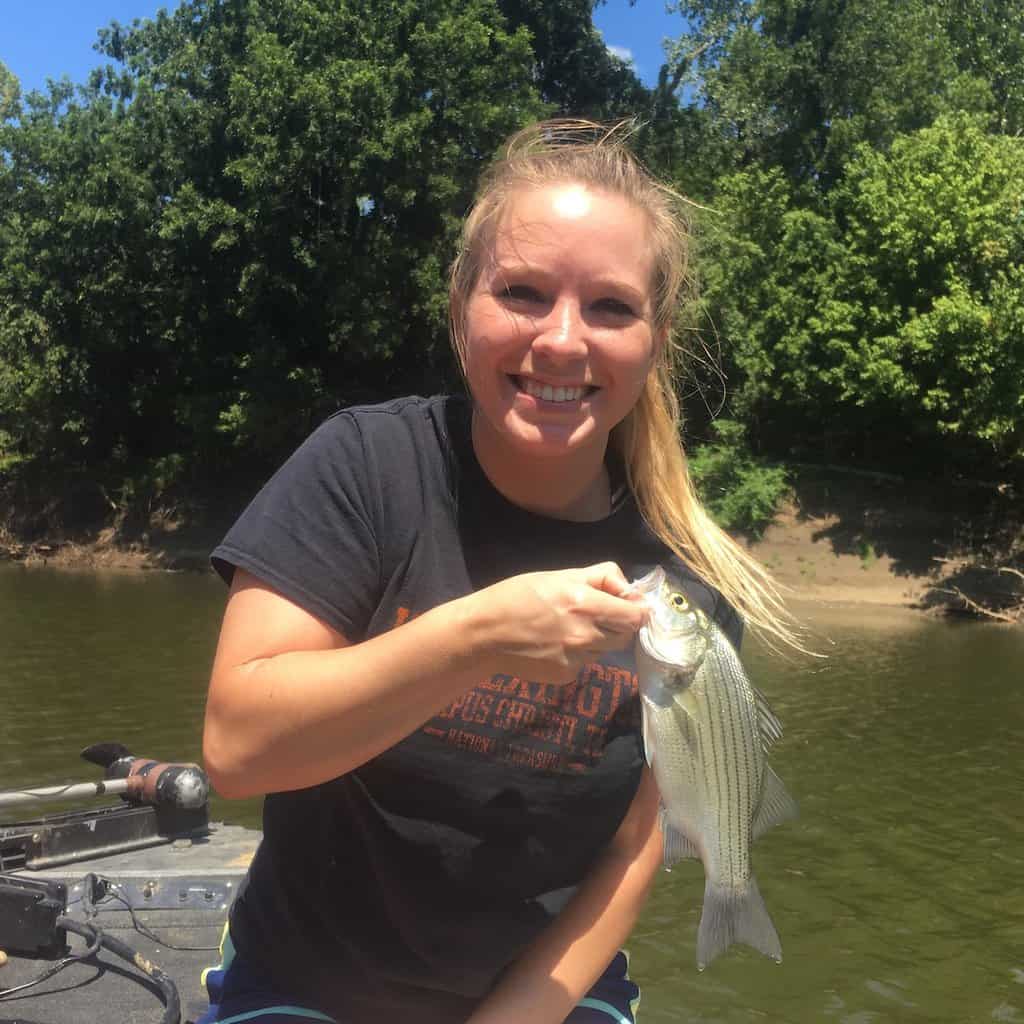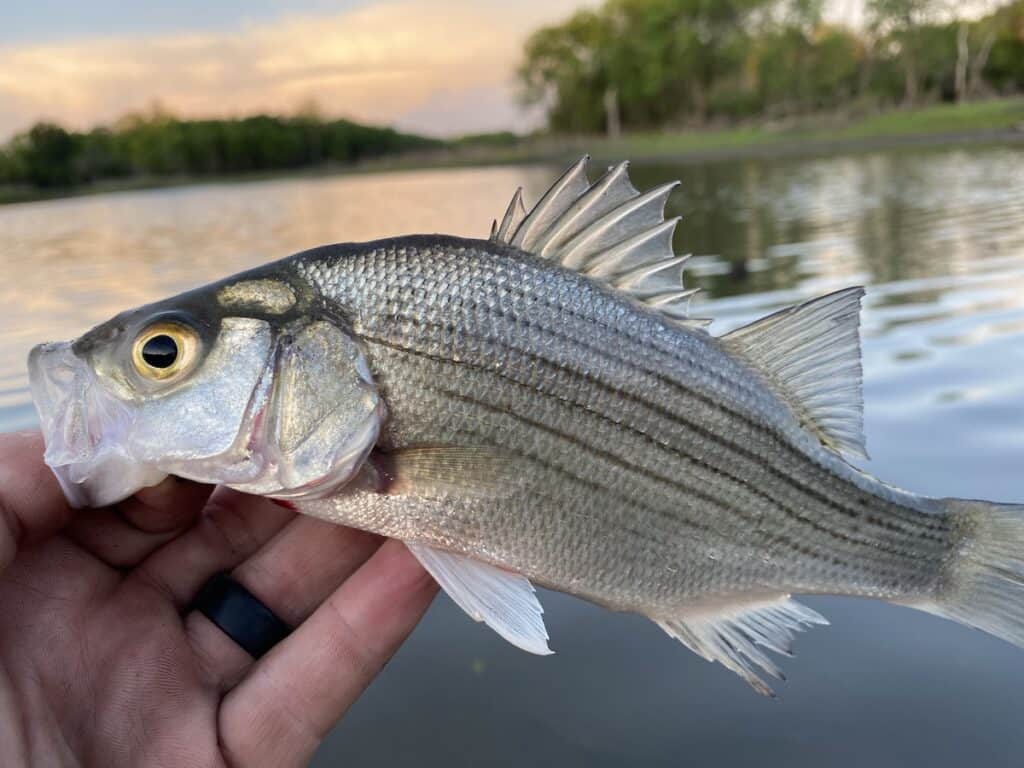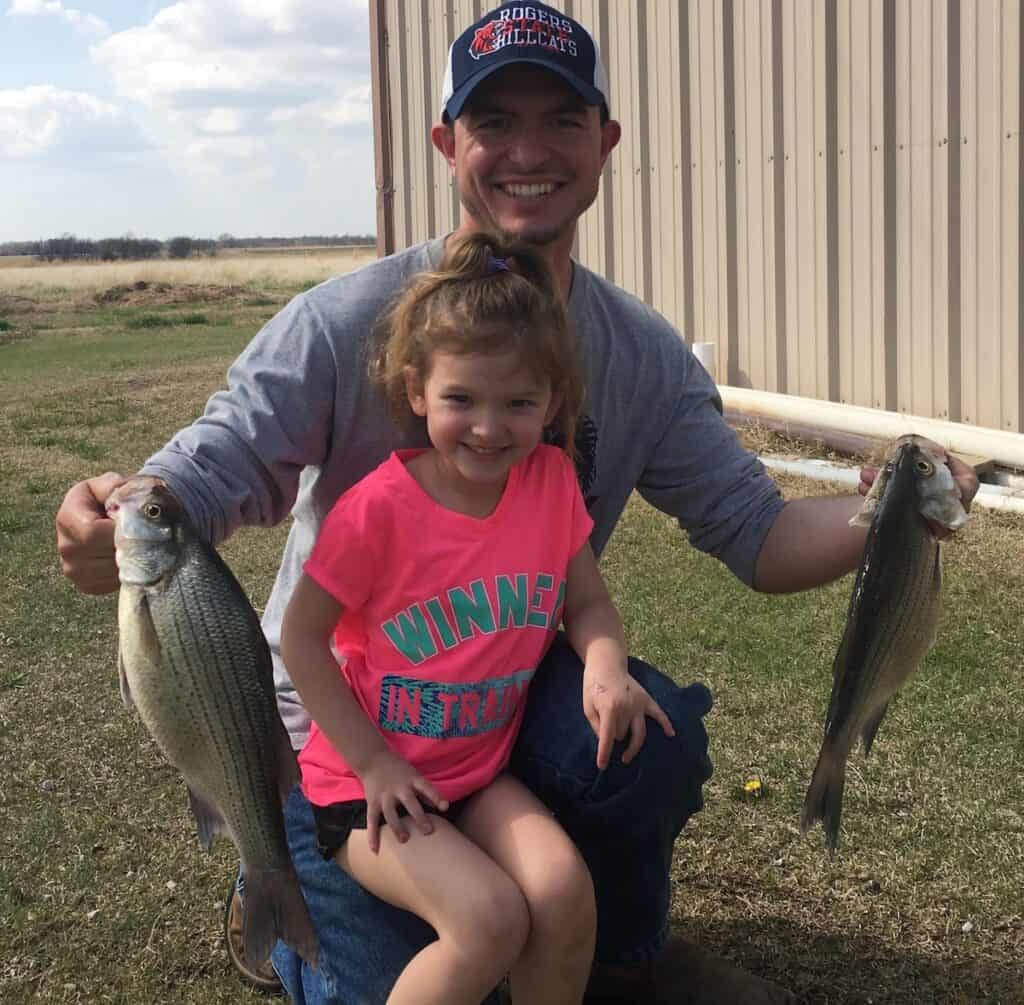White bass are, pound-for-pound, some of the hardest-fighting fish in freshwater. And when you get on an active school, it’s non-stop action.
Growing up in Oklahoma, my dad regularly took me fishing for white bass, which we often call sand bass or simply “sandies.” I remember one specific instance when we caught 25 apiece in about 30 minutes.
However, they’re not always so willing to jump in the boat. So, over the years, I’ve picked up tips from others and learned a few the hard way.
Lucky for you, I’ve condensed my experience into this article, so it won’t take years to learn how to catch white bass.
Let’s start defining a white bass, followed by how to catch ’em!
White Bass Identification
White bass are related to yellow bass and striped bass. A hybrid or hybrid striper most often refers to a white bass crossed with a striped bass, often in a fish hatchery. These combined species also are known as “wipers” or “sunshine bass.”
Yellow bass and white bass often look identical, except for the yellowish color and typically smaller size of yellow bass.
It’s easy for beginners to confuse a small hybrid with a white bass unless you pay attention to the black lines and body shape.
To identify a white or striped bass, confirm that it has unbroken horizontal lines across its back. A hybrid will have broken lines.
Striped bass are much more streamlined than hybrids, which are a little more streamlined than white bass.
Size is another way to identify the differences between species.
White bass don’t get as big as hybrids or striped bass. They typically are 5 pounds or less, so if you catch a fish larger than 6 pounds, it’s probably not a sand bass.
How to Catch White Bass
Now that you know how to identify the different species, it’s time to learn how to catch white bass!
White bass are aggressive, which makes catching them a lot of fun, and not terribly difficult, especially at specific times of the year.
They’ll bite live bait or lures, but check your local regulations on what’s legal to use.
You can catch white bass in varying waterways using different methods.
There’s no one best way to catch them, which is why I enjoy fishing for them.
Best Live Baits for White Bass
I’ve caught white bass using minnows and small shad, their primary food sources.
Minnows
Typically, when I catch a white bass using minnows, it’s while I’m crappie fishing.
I’ll have a bobber with a small weight and a small hook tied on, which is less than ideal for sand bass fishing, but we will discuss the gear you need later.
Small Shad
Shad are another live bait to use for white bass fishing. Unfortunately, they’re difficult to keep alive, especially the small ones that make the best bait.
You can step up your gear size a little when using shad but don’t go too big, as you’ll miss a lot of bites if you do.
Best White Bass Fishing Lures
Using lures is probably my favorite way to catch sand bass because they crush ’em.
Plastic Swimbaits
Using a soft plastic swimbait that imitates a shad is often the ticket for catching loads of white bass.
I prefer using a swimbait over live bait because you don’t have to keep it alive to be effective.
Jigs
As I mentioned earlier, I often catch white bass while crappie fishing. They’re usually small sandies, but they’re still fun, especially on a crappie setup.
If the crappie aren’t biting, I’ll try to locate a few sand bass using a crappie jig.
These small jigs look like minnows. If you’re having trouble catching white bass on a swimbait, consider switching to a crappie jig, the smaller profile might be what they want that day.
Spinners
Spinners including spinnerbaits, Rooster Tails, Mepps, or just about anything else with a flashy blade, will catch sand bass. These lures are often made to look like darting shad.
These are some of my favorite lures to throw in muddy or stained water because they give off a lot of vibration and flash that really gets the white bass fired up.
I’ve lost count of how many times I’ve been largemouth bass fishing with a spinnerbait and caught several white bass.
Spoons
Spoons are another flashy lure I like to use when white bass fishing.
I always use a swivel to help prevent line twist when fishing with a spoon because they twirl in the water.
I prefer to troll with spoons instead of casting them, but I’ve caught sandies doing both techniques.
Crankbaits
Crankbaits are my favorite bait to use for most species, and it’s no different with white bass.
I prefer chrome or white flat-sided crankbaits in the spring and late fall and rounded crankbaits in the summer.
This preference is because flat-sided crankbaits have less action than rounded ones and look more natural in cooler waters.
I will use crankbaits to troll or cast.
As long as you have the crankbait properly tuned, you shouldn’t need a swivel, as you do with a spoon.
Topwaters
Topwater lures can effectively catch white bass when you find a school near the surface.
Spooks, Whopper Ploppers, and various poppers are some of the best topwater lures for white bass. I recommend keeping the colors natural or as close to their main food source as possible.
If you’re lucky enough to find a school of fish blowing up on a school of shad, bust out a topwater and bring it through the chaos to entice some bites.
Where to Fish For White Bass
White bass are native to creeks, rivers, and streams in the central US.
However, they behave differently in these environments, so you’ll need to adapt your approach when fishing in these locations.
One thing that is constant from location to location is depth changes.
White bass love access to deep water near a flat. They use the deep water for safety and the flat for feeding.
Rivers
I fish rivers one of two ways, trolling or casting.
When white bass are in the spawning process, I’ll cast for them when they’re in brush piles, in a deep hole, or cruising shallow sandbars.
My favorite lures to throw in a river are crankbaits and jigs.
Most of the time on the river, I fish from a boat or kayak; however, you can catch sandies from the bank if you can access the river.
Creeks
Fishing creeks for white bass is best done during the spawn when they’re searching for shallow water.
They’ll school up in deep holes and around brush piles before finding a good place to spawn.
Fishing a creek is very similar to fishing a river; the main difference is everything is condensed, so streams are often easier to find and catch fish.
Lakes
White bass fishing in lakes typically requires a boat or kayak because the big schools of sand bass spend most of their time in the main lake away from the shore.
I typically troll around the lake, near depth changes close to a flat, until I locate the schools.
Once I find a school of white bass, I begin casting for them with crankbaits, spoons, or spinners.
As I mentioned, if I see them boiling on the surface, I’ll throw a topwater lure in the middle of the madness.
When to Fish for White Bass
The time of year and time of day you go fishing is one of the most significant contributors to where you’ll need to go to find the fish.
Every day is different; however, I use some general guidelines depending on the season, and you can copy them to put you in the right area.
Spring
White bass spawn during the spring. So heading up creeks and rivers is the best bet at finding sandies.
You might be surprised how far they will swim up the river or creek to spawn. I’ve watched hundreds of sand bass swim in inches of water during the spring to keep heading miles upriver to spawn.
Before white bass spawn, they will stage around brush piles in deep holes near a shallow flat.
Jigs, swimbaits, and crankbaits are my favorite lures to throw at this time of year.
Summer
During the summer, sandies patrol the deep holes of the main lake or river channel.
I love trolling this time of year to find them, because I can cover more water. Spoons and crankbaits are my primary lures for this tactic.
Small spinnerbaits are some of my favorite lures to cast for white bass during the early summer once you’ve found the school.
Fall
The fall brings the white bass back shallow to feed up before winter sets in.
Crankbaits and spinnerbaits are some of the best lures for this time of year.
While you can troll for sandies in the fall, you’ll likely have to locate the school and then stop and cast for them. They’ll be much shallower than they were during the summer.
Winter
Winter is the most challenging time to catch white bass, but it can be done.
Sandies typically school up in the deep holes for winter, but as the water begins to warm in late winter, they’ll start to move shallow.
Time of Day
As with many game fish, I’ve found that the best time of day to cast for sand bass is during the morning. The bright sun hurts their eyes, so they search for deeper water as it rises.
I prefer to troll for white bass late morning and early afternoon because I troll deeper water, and that’s typically where the white bass are during that brightest time of day.
In the late evening, the sandies will begin to move shallow again, which is an excellent time to start casting for them around depth changes.
White Bass Fishing Methods
I use two ways to catch white bass: casting and trolling.
Casting
When casting for white bass, I typically have a target I’m aiming for, whether that’s a brush pile or depth change.
Casting is the most popular method because you can do it from a boat or the shore.
My approach is very similar to largemouth or smallmouth bass fishing: Cast and retrieve and repeat until I get a bite.
If you’re not getting bites, try varying your retrieve speed or lures.
Casting is my favorite way to catch fish, but trolling can also be a lot of fun, especially if that’s what is catching fish.
Trolling
To catch white bass while trolling, start by making one long cast behind your boat with a spoon or crankbait.
Set your speed between 1-2 MPH and hold tightly to your rod.
When trolling rivers, I stay in the middle of the channel as best I can.
However, when trolling in the lake, I try to find depth changes where I think they’ll be that day. That hot spot can be a creek or river channel near flats or in the middle of the lake.
White Bass Fishing Tackle
I like to keep my tackle simple when sand bass fishing. Depending on the situation, I’ll use a couple of different rods, reels, and lines.
Rod & Reel
I like to use a medium-heavy baitcasting rod and reel when using spinnerbaits, swimbaits, and crankbaits, though it’s a less than ideal setup for crankbaits.
I also use this gear for trolling, as trolling requires a more robust setup than casting.
I use a spinning reel for lighter lures such as Rooster Tails, Mepps, and crappie jigs.
I only use a spinning reel when casting. However, if all you own is a spinning reel, you can still troll with it; you just need to set your drag correctly.
Line
I primarily use a 10-12-pound test line for everything white bass. The one exception is using crappie jigs.
Sometimes I’ll use a little lighter line, such as a 6-8 pound test, because the heavier line inhibits the jig’s action.
If I’m trolling with a chance to catch a striped bass or other large fish, I’ll use a baitcaster reel spooled with a 50-pound braided main line and a 17-pound fluorocarbon leader.
I primarily use a fluorocarbon leader unless I’m topwater fishing; then, I’ll use a monofilament leader.
Best White Bass Fishing Spots
Click the following states to find the best white bass fishing lakes and rivers in each location.



